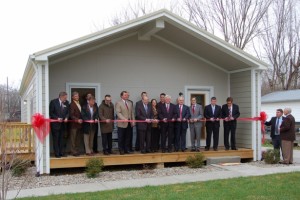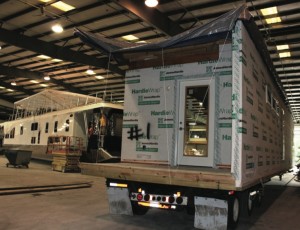Uninsurable Home = Deficient Inspection Report?
A new danger for home inspectors is beginning to raise its ugly head.
Homeowners insurance.
That’s right. Good ol’ homeowners insurance.
Getting homeowners insurance used to be like going to a good neighbor. It was there. You were in good hands. You hand over a check, they hand over insurance.
Those days are fading fast.
More and more home buyers are being denied homeowner insurance. Even more are being told they will not get insurance unless they fix up the home. Without the insurance, closings are being called off or delayed. Then comes the blame game.
For home inspectors and their home buying clients, it’s a real problem. So far, the Kentucky Board of Home Inspectors has been no help.
What’s going on?
Two things. First, the “claims history” of the home. Second, hazardous conditions.
Here’s how it works, and some tips on handling the risk for home inspectors.
Insurers always the claims history of a home before issuing insurance. Water damage claims are red flags, for example. But evening having a homeowner inquire about coverage, without even filing a claim, can set off an alarm these days.
Claims are researched through CLUE (the “Comprehensive Loss Underwriting Exchange”). CLUE is an insurance industry database of claims. Insurers get a CLUE report that says whether any claims were filed in the last five years by either the buyer or seller.
“Even if you currently own a home and have a squeaky clean claims history, if you buy a house with multiple claims against it, you may not be able to obtain insurance coverage,” the AAA warned members this October.
One problem is that only the homeowner can order a CLUE report. Homeowners can order a copy from ChoicePoint, the company that runs the CLUE database. (It’s owned by Reed Elsevier, the corporate parent of Lexis Nexis. For more, http://www.reedelsevier.com/OurBusiness/LexisNexisRiskSolutions/Pages/CLUE.aspx).
ChoicePoint was fined $10 million by the Federal Trade Commission in 2008 for violating the Fair Credit Reporting Act by turning over private info to improper people, before Reed Elsevier bought it. It was the largest civil penalty in FTC history at the time. http://www.ftc.gov/opa/2006/01/choicepoint.shtm.
If the CLUE report flags water damage, or roof claims, but the home inspection report does not, there’s a recipe for trouble.
The same is true for “hazardous conditions.” Except there is no one, single database or source, like CLUE.
Roughly a majority of home insurance companies in the Kentucky market require repairs of unsafe conditions, whether they learn about them through the home inspection report, the appraisal, or from an agent’s visit to estimate replacement cost for the home. Some decline coverage when a Federal Pacific Electric Co. panel is in use; others do not.
Here again, trouble can be brewing.
Professional Learning Institute in working to see if a set of reasonable standards can be published for home inspectors to help avoid conflicts. Stay tuned for the next Newsletter.
Source: “Home Buyers: Make Homeowner’s Insurance a top priority,” AAA Traveler, October, 2012.
Houseboats
The second home in Kentucky, built in a houseboat factory here, is being occupied as you read this.
It is part of the “Houseboats to Energy Efficient Residences Project” (or “HBEER”), a collaboration of the UK College of Design, the Kentucky Highlands Investment Corporation, and the federal Economic Development Administration. Funding included two stimulus grants from the U.S. Dept. Of Energy.
The first home was occupied in Monticello, KY early this year.
Today, HBEER is creating green jobs and bringing back to work some of the 575 skilled workers and 1,000 related jobs that were lost in the houseboat manufacturing and marine industries due to the economy.
“The transfer of knowledge and expertise gained during the HBEER project traces the path of an arc leading directly from design research conducted at the University of Kentucky to design products meant to address important energy and economic needs of communities in the Commonwealth of Kentucky and beyond,” said UK College of Design Dean Michael Speaks.
The challenge: Design a house that can be built for $100,000 (including a $10,000 lot), that costs $1 a day for
energy, that is made with 70% Kentucky products, The first was built in Stardust Cruisers factory and trucked
a few miles away to Monticello. It uses 40% less water and 50% less electricity than a conventional house.
It is just the beginning of transplanting college learning and research to the homes we see and where our
neighbors will live.
Among highlights of the HBEER project:
Estimated energy costs are about $1.65 per day, which is one-half to one sixth of energy bills for other housing alternatives.
More than 80 percent of the home value is derived from products made in Kentucky, creating or saving further jobs.
The HBEER project partners include the University of Kentucky College of Design, UK Center for Applied Energy Research, and Kentucky Highlands Investment Corporation.
Learn more at The Lane Report, the magazine of Kentucky business: http://www.lanereport.com/2265/2012/02/uks-hbeer-helps-houseboat-makers-set-a-new-course/
For more, UK has a video.
http://www.uky.edu/design/index.php/features/article/ribbon_cutting_marks_completion_of_first_hbeer_home/#0


